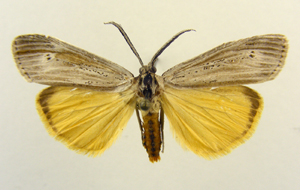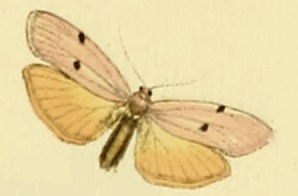
The Lymantriinae are a subfamily of moths of the family Erebidae. The taxon was erected by George Hampson in 1893.

The Phaegopterina are a subtribe of tiger moths in the tribe Arctiini, which is part of the family Erebidae. The subtribe was described by William Forsell Kirby in 1892. 469 species of Phaegopterina are present and 52 that are recently discovered in Brazil.

Brunia is a genus of tiger moths in the family Erebidae. The genus was erected by Frederic Moore in 1878.
Collita is a genus of moths in the family Erebidae. The genus was erected by Frederic Moore in 1878.

Cycnia is a genus of tiger moths in the family Erebidae. The genus was erected by Jacob Hübner in 1818.
Dolgoma is a genus of moths in the family Erebidae. The genus was erected by Frederic Moore in 1878.

Dysauxes is a genus of moths in the family Erebidae. The genus was erected by Jacob Hübner in 1819.

Eilema is a genus of moths in the subfamily Arctiinae. The genus was erected by Jacob Hübner in 1819.
Gandhara is a genus of moths in the subfamily Arctiinae. The genus was erected by Frederic Moore in 1878.

The Aganainae are a small subfamily of moths in the family Erebidae. The adults and caterpillars of this subfamily are typically large and brightly colored, like the related tiger moths. Many of the caterpillars feed on poisonous host plants and acquire toxic cardenolides that make them unpleasant to predators. Like the closely related litter moths, the adults have long, upturned labial palps, and the caterpillars have fully or mostly developed prolegs on the abdomen. The Aganainae are distributed across the tropics and subtropics of the Old World.

Wittia sororcula, the orange footman, is a species of moth in the family Erebidae. The species was first described by Johann Siegfried Hufnagel in 1766. It is found in Europe, Anatolia and further east across the Palearctic to southern Siberia and the Amur basin to China.

Pelosia is a genus of moths in the family Erebidae. The genus was erected by Jacob Hübner in 1819.
Phlyctaenogastra is a genus of moths in the family Erebidae erected by Max Gaede in 1915.
Zadadra is a genus of moths in the subfamily Arctiinae.

The Museum Witt Munich (MWM) is a department of the Bavarian State Collection of Zoology. It is located in Munich, Germany, and has the world's leading collection of moths.

Afrocoscinia is a curious genus of tiger moths in the family Erebidae erected by Vladimir Viktorovitch Dubatolov in 2011. The genus includes only one species, Afrocoscinia aethiopica, described by Lars Kühne in 2010, which is found in the arid regions of the western part of South Africa. By the general appearance of wing and body shape, it looks like species of the Palearctic genus Coscinia from Callimorphina. But many other characteristics of this moth show that is it a member of the Nyctemerina.

Zobida bipuncta is a moth of the subfamily Arctiinae. It is found in Larache, Morocco and the southern part of the Iberian Peninsula.
Zobida avifex is a moth of the subfamily Arctiinae first described by Lars Kühne in 2010. It is found in South Africa and Zimbabwe.
Tarika is a monotypic moth genus of the subfamily Arctiinae in the family Erebidae. Its only species, Tarika varana, is found in Sikkim, India. The genus and species were both first described by Frederic Moore; the genus in 1878 and the species in 1866.
Eilema albostriatum is a moth of the subfamily Arctiinae first described by Lars Kühne in 2010. It is found in Namibia and South Africa.











